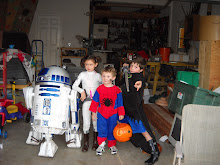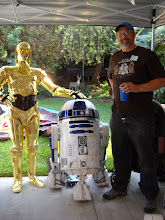
This is the whole package for the builder who commissioned these from me. I'd probably put a coat of black paint on the hubs if they were going in my droid. I'm happy with the results:




The only remaining flaws at this point are very small and will be covered by paint. The next steps would be to add a few more coats of primer with some very light sanding--maybe with 00 or 0000 steel wool in between--then several light coats of a gloss white with some light sanding in between the early ones.
What did I learn this time through:
I got the high end baltic birch 12 ply plywood. It's very good, stable, and straight. But the outermost layer, the layer that will end up showing to the eye, is fragile. Home Depot and Lowe's usually have some good 12 ply cabinet grade plywood, and I have found that the outer layer on that stuff is a bit thicker and a bit more sturdy. I'd go with that next time. I'd also cut a 3" circle out of the insider layer of the legs at the top where the shoulder hub is going to sit, although the router method I used yesterday wasn't too bad. The router method for cutting the pockets out under the shoulders is a very clever idea I got from Mike Senna through Victor Franco. The best way was to have a couple, but not all, of the layers glued, and then rout out the pockets with a template from the inside. Each leg weighs several pounds. I think that next time, I could rout out a lot of material on the insides of the pieces without compromising the strength at all. The ankles could have a lot of interior material removed, the channel for the wiring could be wider, and the shoulders could be more hollow. That could save a pound or two per leg, and that would add up. The modification to the center leg tip to make a better connection to the foot shell is an improvement. Next time, if I was setting up a fixed three legged droid, I think I'll work out the plans to do that on all three legs--building the ankle locks into the design.





















